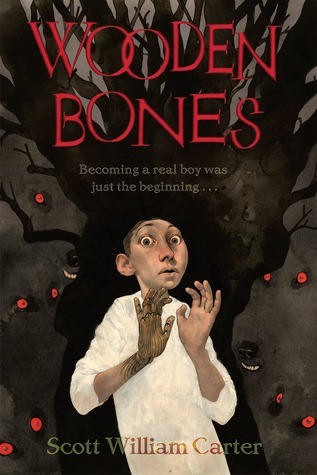 Fairytales generally end the same way: happily ever after. But I’ve never been able to help but feel that it’s a bit of a stretch to ask me to actually believe that they do just sort of float through life happily ever after, so I love seeing follow-ups to, and riffs off of, some of the more popular traditional fairytales!
Fairytales generally end the same way: happily ever after. But I’ve never been able to help but feel that it’s a bit of a stretch to ask me to actually believe that they do just sort of float through life happily ever after, so I love seeing follow-ups to, and riffs off of, some of the more popular traditional fairytales!
In Wooden Bones, Scott William Carter explores concerns I’d say were noticeably absent in the original Pinocchio by Carlo Collodi – why being a real boy is necessarily better than being a wooden puppet, for example*, or developing a concept of identity that is not dependent upon being a boy of flesh and bone – while still adhering more or less to the fairytale structure. Pino, the boy formerly known as Pinocchio (because Pinocchio is too long and cumbersome for everyday use, according to Gepetto), discovers that apart from just being a magical boy, in the sense that he became a real boy only with the aid of magic, he truly is a magical boy, in that unlike regular real boys, he has magical powers.
Of course, these magical powers only bring him trouble (as well as helping him get out of trouble by digging himself a bigger hole), but the trouble is what prompts him to come to the realization that it doesn’t matter whether he’s a real boy or a wooden puppet boy: he’s Pinocchio, and perhaps more importantly, Gepetto won’t love him any less for being one or the other.
The prose is well written and I almost feel like it’s directed at an adult audience at times in its phrasing, but the facile construction of the characters and straightforwardly easy development of the plot point almost completely to a junior novel. (I say “almost” only because that structure could have been meant to replicate the simplicity found in fairytales.) Carter gives Pino various challenges and employs deus ex machina whenever needed to prevent complications from arising, but you have to wonder: whatever happened to the fairy that helped Pino out in the cave? She resembles the woman they meet later, sure, but it’s pointedly not her. (Contrast that with the original Pinocchio, where the woman who resembles the fairy is her, in disguise.) Wolves are introduced, then lost not long after they have served their purpose of leading Pino and Gepetto to the cave. Pino destroys several towns/communities and we never hear what becomes of them. That girl he meets in the community that lives on the treetops that he never meets again. It’s the fairytale formula, of course, in novel form, and Carter does a spectacular job incorporating these little details in the form the story takes, as well as in the details (and lack thereof in the right parts)! Wooden Bones is the only novel we have by Carter, but if you haven’t read the original Adventures of Pinocchio by Collodi, you’re definitely missing out, so I’ll even specially link them directly for you to check out.
- We’ve got a bunch of different editions, so here’s the list of everything by Carlo Collodi.
- I personally read this edition and the drawings are beautiful! There’s an odd mix between realism and cartoon that meshes well with the fantastical elements of an otherwise somewhat logical (or at least, not completely nonsensical) storyline, along with a slight bit of creepiness that seeps into the realism, again relating well to the darker aspects of the plot.
- Also, by the way: it’s a shark, not a whale. This changes everything.
- If you can read Italian, you can even read it in the original: La Avventure di Pinocchio.
*Arguably, Carter doesn’t really address this outright. It’s kind of a mix between why real boy > wooden puppet boy, and how that factors into Pino’s sense of identity.